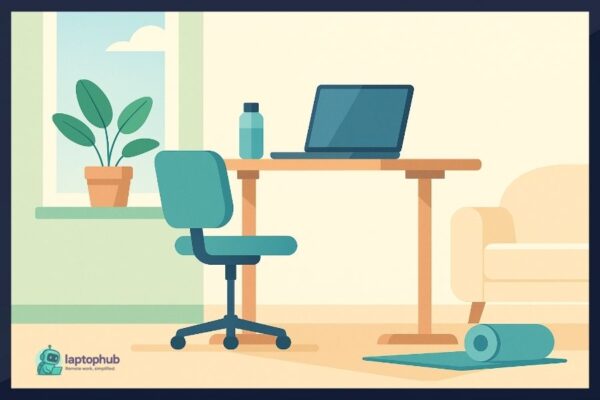Working from home offers freedom, but it also quietly rewires how you live and think. Without clear lines between work and life, the mental load builds fast—loneliness creeps in, burnout sneaks up, and focus slips away. That’s why mental health tips for remote workers aren’t optional—they’re essential. If you’re going to thrive outside a traditional office, you’ll need more than just discipline and a laptop—you’ll need real strategies that protect your mind, your time, and your sense of self.
💡Key takeaways:
- Remote workers need structure and boundaries to prevent burnout and maintain focus.
- Regular movement, proper nutrition, and intentional breaks are essential for mental wellness when working from home.
- Social connection and mindful tech usage help combat isolation and digital fatigue.
- Long-term sustainability requires proactive attention to stress, energy levels, and emotional health.
1. Start and end your day with intention
Without a clear start or finish, your day stretches into a fog. You might think you’re multitasking, but you’re actually just tired, distracted, and more prone to burnout.
What to do:
- Choose a start time and stick to it.
- Signal your day’s beginning by doing something consistent: make coffee, walk the dog, or write down your top three priorities.
- Set a shutdown routine. Close your laptop. Write tomorrow’s to-dos. Physically leave your workspace.
These habits anchor your day and train your brain to switch between “work mode” and “rest mode.”
2. Ditch the pajamas
You don’t need to wear business attire to answer emails. But staying in what you slept in can drag your energy down and blur the mental line between working and lounging.
Upgrade your mindset with small wardrobe changes:
- Get dressed in something casual yet presentable.
- Change into leisure clothes when your workday ends to signal relaxation.
- Keep it simple, but intentional.
Your outfit influences your mindset more than you think.
🖥️Also read: 11 Best Ergonomic Practices for Home Offices That Actually Work
3. Create a dedicated workspace (no, your bed doesn’t count)
One of the best things you can do for your mental health when working remotely is to define where work happens. Blurring physical boundaries can lead to sleep problems, back pain, and mental fatigue.
Build a work-only zone:
- Set up a desk, even a small one, separate from where you eat or sleep.
- Use a real chair, not the couch.
- Keep your workspace clean and clutter-free. Visual chaos = mental chaos.
This isn’t about aesthetics—it’s about giving your brain spatial cues to focus or relax.
🖥️Also read: How to Build the Perfect Home Office Setup—Even in Small Spaces
4. Don’t skip breaks. They’re not optional.
When you’re not surrounded by coworkers or a change of scenery, it’s easy to sit in front of your screen for hours on end. That’s a fast track to burnout.
How to make breaks work:
- Try the 50/10 method: 50 minutes of work, 10 minutes away from the screen.
- Get sunlight. A five-minute walk outside beats twenty minutes scrolling indoors.
- Set a timer if you tend to forget.
Breaks aren’t wasted time—they’re recovery time.
🖥️Also read: Pomodoro Technique for Remote Workers: Boost Focus and Productivity from Home
5. Move your body every day
Remote work means fewer steps, fewer commutes, and less incidental movement. That physical stillness builds up in your muscles and your mood.
Ways to move without going full gym rat:
- Stretch for five minutes before your first meeting.
- Use a standing desk or take calls while walking.
- Dance around to a playlist after lunch.
Movement clears mental fog. It doesn’t have to be intense—it just has to be consistent.
6. Don’t isolate yourself
One of the biggest mental health challenges in remote work is loneliness. You lose the casual interactions that came with office life. And over time, the silence can weigh on you.
Combat this with active connection:
- Schedule virtual coffee chats or coworking sessions with friends or peers.
- Use coworking platforms like Focusmate or join niche Slack groups.
- If possible, meet up with local remote workers once a week—even if it’s just at a café.
Social interaction is a basic need, not a luxury.
7. Stay hydrated and eat like you actually care
Skipping meals, snacking on sugar, or forgetting to drink water? That’s not just bad for your body—it directly affects your focus, mood, and stress levels.
How to stay fueled and focused:
- Start your day with water before coffee.
- Prep lunch in advance so you don’t skip it when the workload ramps up.
- Keep healthy snacks within arm’s reach—nuts, fruit, boiled eggs, whatever works.
The goal isn’t to eat like a fitness influencer. It’s to avoid the crash that comes from junk-fueled, coffee-only days.
8. Set boundaries with people you live with
Roommates, partners, and kids don’t always understand that “working from home” doesn’t mean “always available.”
Set expectations early:
- Use visual cues like headphones or door signs during deep work.
- Agree on shared quiet hours if possible.
- Communicate your schedule like you would with a boss.
Respect flows both ways. If you want focus time, you have to claim it.
9. Use technology intentionally
Apps, alerts, and inboxes can either help you or destroy your focus. When you’re remote, it’s easy to feel like you have to respond instantly to everything.
Take control of your tech:
- Turn off non-essential notifications.
- Batch email replies instead of answering every message in real time.
- Use tools like Clockify, Notion, or Todoist to track your day—don’t let it track you.
Let your tools work for you, not the other way around.
10. Practice micro-mindfulness
You don’t need to meditate for 30 minutes to be mindful. You just need to pause long enough to reconnect with your breath, your body, or the present moment.
Simple mindfulness practices:
- Before a meeting, take three deep breaths instead of jumping in.
- When you feel overwhelmed, name what you’re feeling. Out loud.
- Do a quick body scan while sipping coffee.
Presence lowers stress. And it only takes a few seconds.
11. Watch for burnout signs—then actually do something
Burnout in remote work doesn’t always look like collapsing on the floor. Sometimes it’s low-level dread, brain fog, or a constant feeling of being behind—even if you’re hitting deadlines.
Know what to look for:
- Chronic fatigue, even after sleep
- Reduced joy or motivation for work
- Getting easily irritated or checked out
- Trouble focusing on simple tasks
Don’t push through. Take a mental health day. Offload tasks. Tell your team. Get support.
12. Seek help when you need it
If you’re feeling depressed, anxious, or mentally exhausted for more than a few weeks, it’s time to talk to someone. No productivity hack replaces professional care.
Accessible options:
- Online therapy platforms like BetterHelp or Talkspace
- Local therapists offering video sessions
- Company-provided Employee Assistance Programs (EAP)
You’re not weak for needing help. You’re wise for asking.
13. Track your energy, not just your time
Time management is useful. But energy management is what keeps you from burning out.
Try this:
- Note what tasks drain or boost you.
- Align creative work with your peak energy hours.
- Don’t book back-to-back Zoom meetings for three hours. Your brain will quit on you.
This helps you stop working more—and start working better.
Frequently asked questions (FAQs)
The best tips include setting clear work hours, taking regular breaks, staying socially connected, exercising daily, and protecting your boundaries.
Prevent burnout by managing your energy, scheduling downtime, avoiding overwork, and recognizing early signs of emotional exhaustion.
Mental health is essential because remote work can increase isolation, blur work-life boundaries, and make it easier to overlook stress until it leads to burnout.
Stay connected by scheduling virtual check-ins, joining online communities, and making time for real conversations outside of work.
Yes, working from home can contribute to anxiety, depression, or burnout if not managed with healthy routines and social interaction.
Final thoughts
Remote work isn’t going anywhere—but your energy, joy, and well-being might if you don’t defend them. The key to thriving in this environment isn’t squeezing more out of your hours; it’s building a lifestyle that supports clarity, connection, and calm. These mental health tips for remote workers are more than suggestions—they’re survival strategies. Your mental health is the most important productivity tool you own—treat it like it matters.





